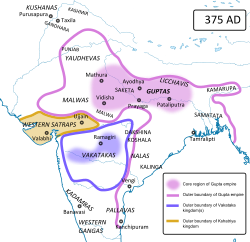
Back সমতট Bengali/Bangla Samatata Catalan Samatata French სამატატა Georgian Samatata Lithuanian समतट Nepali சமதாத இராச்சியம் Tamil
Samataṭa | |||||||||||
|---|---|---|---|---|---|---|---|---|---|---|---|
| 3rd century BCE–13th century | |||||||||||
Samatata coinage of Vira Jadamarah, imitative of the Kushan coinage of Kanishka I. The text of the legend is a meaningless imitation, c. 2nd–3rd century CE.[1]
| |||||||||||
 Samataṭa and erstwhile states of ancient India in 375 CE | |||||||||||
| Common languages | Magadhan Prakrit, Sanskrit | ||||||||||
| Religion | Hinduism, Buddhism | ||||||||||
| Government | Monarchy | ||||||||||
| Recorded dynasties | |||||||||||
• 3rd century BCE-1st century BCE | Mauryan Empire | ||||||||||
• 3rd century-6th century | Chandra dynasty (as vassals of Gupta Empire)[2] | ||||||||||
• 6th century-7th century | Gauda Kingdom[3] | ||||||||||
• 7th century-8th century | Khadga dynasty | ||||||||||
• 8th century-9th century | First Deva dynasty[4] | ||||||||||
• 9th century-10th century | Chandra dynasty (continued) | ||||||||||
• 10th century-11th century | Varman Dynasty | ||||||||||
• 11th century-12th century | Sena dynasty | ||||||||||
• 12th century-13th century | Second Deva dynasty | ||||||||||
| History | |||||||||||
• Established | 3rd century BCE | ||||||||||
• Disestablished | 13th century | ||||||||||
| |||||||||||
Samataṭa (Brahmi script: ![]()
![]()
![]()
![]() sa-ma-ta-ṭa) was an ancient geopolitical division of Bengal in the eastern Indian subcontinent. The Greco-Roman account of Sounagoura is linked to the kingdom of Samatata. Its territory corresponded to much of present-day eastern Bangladesh (particularly Dhaka Division, Sylhet Division, Barisal Division and Chittagong Division) and parts of the Rakhine State of Myanmar. The area covers the trans-Meghna part of the Bengal delta. It was a center of Buddhist civilisation before the resurgence of Hinduism and Muslim conquest in the region.
sa-ma-ta-ṭa) was an ancient geopolitical division of Bengal in the eastern Indian subcontinent. The Greco-Roman account of Sounagoura is linked to the kingdom of Samatata. Its territory corresponded to much of present-day eastern Bangladesh (particularly Dhaka Division, Sylhet Division, Barisal Division and Chittagong Division) and parts of the Rakhine State of Myanmar. The area covers the trans-Meghna part of the Bengal delta. It was a center of Buddhist civilisation before the resurgence of Hinduism and Muslim conquest in the region.
Archaeological evidence in the Wari-Bateshwar ruins, particularly punch-marked coins, indicate that Samataṭa was a province of the Mauryan Empire. The region attained a distinct Buddhist identity following the collapse of Mauryan rule. The Allahabad pillar inscriptions of the Indian emperor Samudragupta describe Samataṭa as a tributary state.
Samataṭa gained prominence as an important region of Bengal during the reigns of the Gauda Kingdom, Khadga dynasty, First Deva dynasty,[5][4] Chandra dynasty and Varman dynasty between the 6th and 11th centuries. During this period, the rulers of Samataṭa also reigned over parts of Arakan, Tripura and Kamarupa. Chinese travellers provide an elaborate description of the kingdom during the 7th century. Xuanzang visited the kingdom.
Records of the Sena dynasty include mention of Samataṭa as a haven for Sena kings who escaped the Muslim conquest of western Bengal during the 13th century. The area was eventually absorbed by the forces of the Delhi Sultanate.
- ^ "Samatata coin". British Museum.
- ^ Singer, Noel F. (2008). Vaishali and the Indianization of Arakan. APH Publishing. ISBN 978-81-313-0405-1.
- ^ Prasad, Bindeshwari (1977). Dynastic History of Magadha. p. 136.
- ^ a b Sein, U. Aung Kyaw (May 2011). Vesāli: Evidences of Early Historical City in Rakhine Region (MA). University of Yangoon.
- ^ Singer, Noel F. (2008). Vaishali and the Indianization of Arakan. New Delhi: APH Publishing Corp. ISBN 978-81-313-0405-1. OCLC 244247519.
![Samatata coinage of Vira Jadamarah, imitative of the Kushan coinage of Kanishka I. The text of the legend is a meaningless imitation, c. 2nd–3rd century CE.[1] of](http://upload.wikimedia.org/wikipedia/commons/thumb/3/33/Bengal._Samatata._Coin_of_Vira_Jadamarah_imitative_of_Kushan_coinage_of_Kanishka_I._Circa_2nd-3rd_century_CE.jpg/280px-Bengal._Samatata._Coin_of_Vira_Jadamarah_imitative_of_Kushan_coinage_of_Kanishka_I._Circa_2nd-3rd_century_CE.jpg)